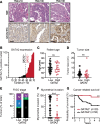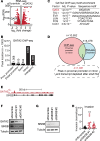Loss of GATA2 promotes invasion and predicts cancer recurrence and survival in uterine serous carcinoma
- PMID: 40168074
- PMCID: PMC12128953
- DOI: 10.1172/jci.insight.187073
Loss of GATA2 promotes invasion and predicts cancer recurrence and survival in uterine serous carcinoma
Abstract
BACKGROUNDA priori knowledge of recurrence risk in patients with nonmetastatic (International Federation of Gynecology and Obstetrics [FIGO] stage I) uterine serous carcinoma (USC) would enable a risk-stratified approach to the use of adjuvant chemotherapy. This would greatly reduce treatment-related morbidity and be predicted to improve survival.METHODSGATA2 expression was scored by IHC across a retrospective multiinstitutional cohort of 195 primary USCs. Associations between GATA2 levels and clinicopathologic metrics were evaluated using Student's t test, Fisher's exact test, Kaplan-Meier method, and Cox proportional hazard ratio. Invasion in patient-derived USC cells was assessed by Student's t test. RNA-Seq, anti-GATA2 ChIP-Seq, and confirmatory Western blotting enabled identification of GATA2 targets.RESULTSPatients with FIGO stage I GATA2hi USCs had 100% recurrence-free and 100% cancer-related survival, which was significantly better than patients with GATA2lo USCs. In patients for whom adjuvant chemotherapy was omitted, patients with GATA2hi USC had 100% recurrence-free 5-year survival compared with 60% recurrence-free survival in patients with GATA2lo USC. Depletion of GATA2 in patient-derived USC cells increased invasion in vitro.CONCLUSIONRoutine GATA2 IHC identifies 33% of patients with FIGO stage I USC who have a greatly reduced risk of posthysterectomy USC recurrence. Our results suggest that a GATA2-guided personalized medicine approach could be rapidly implemented in most hospital settings, would reduce treatment-related morbidity, and would likely improve outcomes in patients with USC.FUNDINGNIH grants R01 DK068634, P30 CA014520, S10 OD023526, K08 DK127244, T32 HL007899, the UW-Madison Department of Pathology and Laboratory Medicine, the UW-Madison Centennial Scholars Program, the Diane Lindstrom Foundation, the American Cancer Society, the V Foundation, The Hartwell Foundation, and the UMN Department of Obstetrics, Gynecology, and Women's Health.
Keywords: Cancer; Clinical Research; Obstetrics/gynecology; Oncology; Tumor suppressors.
Figures





References
-
- NCI. Cancer Stat Facts. https://seer.cancer.gov/statfacts/html/corp.html Accessed March 25, 2024.
MeSH terms
Substances
Grants and funding
LinkOut - more resources
Full Text Sources
Medical

